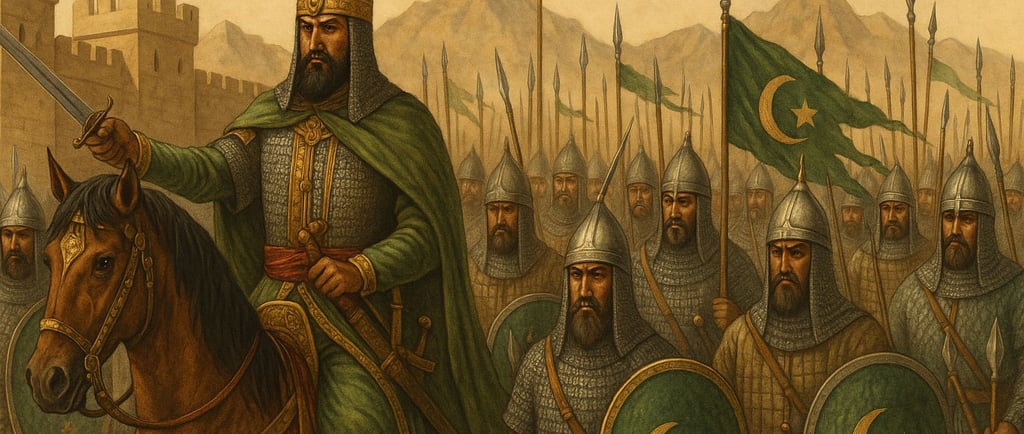The Rise and Fall of the Ghaznavid Empire's Monetary System: Lessons in Gold and Silver Investment
EDUCATION ON GOLD & SILVER


Introduction to the Ghaznavid Empire
The Ghaznavid Empire was a significant power in the Islamic world during the late 10th to the 12th centuries. Established by Alptagin in the late 900s, this empire emerged from the twilight of the Samanid dynasty, marking a critical turn in the history of present-day Afghanistan and surrounding regions. The empire's early capital was established in Ghazni, a strategically vital city located along important trade routes connecting Central Asia and the Indian subcontinent. This location not only facilitated military campaigns but also proved to be essential for economic prosperity.
Under the leadership of Mahmud of Ghazni, who ruled from 998 to 1030, the Ghaznavid Empire reached its zenith. His reign was marked by a series of military campaigns that extended the empire's reach into northern India, culminating in significant victories and territorial expansions. Mahmud's conquests, notably the raids into the Indian subcontinent, established a paradigm for the influence of Islamic powers in South Asia, and these efforts marked key historical milestones such as the control over cities like Lahore and Multan. These military successes were accompanied by an ambition to establish a centralized administration and promote the Islamic cultural and economic frameworks.
The Ghaznavid Empire's monetary system played a critical role during this period of expansion and consolidation. Coinage became a vital means of stimulating trade, reflecting the era's economic interactions with neighboring civilizations. The introduction of gold and silver coins not only enhanced commerce but also provided insights into the empire's wealth and ambitions. The expansion of the Ghaznavid Empire laid the foundation for its monetary policies, which would later become essential in understanding regional economic patterns and influence trade practices across a broader territory.
The Ghaznavid Monetary System: Structure and Key Features
The Ghaznavid Empire, which flourished from the late 10th to the 12th century, established a sophisticated monetary system primarily based on gold and silver. The two most significant coins minted during this period were the gold dinar and the silver dirham, both of which became critical components of trade and military financing. The gold dinar, in particular, was emblematic of wealth and power, often used for significant transactions, while the silver dirham served as a more widespread medium of exchange for everyday commerce.
Under the reign of leaders such as Mahmud of Ghazni, the Ghaznavid monetary system saw a formalization that facilitated not only domestic trade but also interactions along major trade routes, including the Silk Road. These coins bore inscriptions that not only indicated the value but also reinforced the authority of the state, as they often featured the name of the ruling monarch. This served a dual purpose of standardizing currency and promoting the legitimacy of Ghaznavid rulers.
The minting process was closely regulated, ensuring that the coins maintained their integrity and value. The Ghaznavid Empire's approach to coinage had profound implications for its economy. By enforcing a stable monetary policy, the empire could effectively fund its military expeditions and administrative costs while stimulating economic growth. The influx of wealth through trade, bolstered by a reliable currency, contributed to the empire's expansion and its ability to exert influence over neighboring regions.
In this context, the effective management of monetary resources allowed the Ghaznavid Empire to capitalize on its geographical position and thrive economically. The implementation of sound monetary policies not only facilitated internal trade but also enhanced the empire's role as a key player in international commerce, demonstrating the importance of a strong monetary system in fostering economic prosperity.
Influential Leaders and their Economic Policies
The Ghaznavid Empire, which flourished in the 10th to 12th centuries, was profoundly shaped by its prominent leaders, particularly Mahmud of Ghazni. Ascending to power in 997, Mahmud initiated a series of military campaigns that not only expanded the empire's territories but also significantly bolstered its treasury. By successfully raiding prosperous regions such as the Indian subcontinent, he amassed considerable riches which were key to the empire’s economic strategies. These wealth accumulation strategies allowed for substantial state-sponsored projects, paving the way for advancements in trade, agriculture, and infrastructure.
Mahmud's policies aimed at standardizing currency were a crucial advancement during his reign. The introduction of a gold dinar and silver dirham helped streamline trade and solidify economic stability, thereby enhancing market confidence within the empire. These efforts made it possible for the Ghaznavid economy to flourish in an era where trade was paramount. Mahmud's successors continued these policies, albeit with varying degrees of success. Sultan Mas'ud, for instance, maintained Mahmud's monetary strategies but faced increasing challenges, including the overextension of military campaigns that strained resources.
However, the ambitious military expansions and economic policies eventually sowed the seeds for the empire’s decline. The relentless pursuit of conquest, coupled with the need to fund numerous campaigns, depleted the Ghaznavid treasury and strained the operational capacity of the empire. By the mid-12th century, the influx of wealth could no longer compensate for overreaching ambitions, leading to infrastructural decay and discontent among the populace. As the social and economic fabric began to fray, the inability to maintain a stable monetary system ultimately led to the empire’s disintegration, illustrating the vital connection between leadership, economic policy, and the longevity of an empire.
Lessons from the Ghaznavid Empire: Importance of Precious Metals in Today’s Economy
The Ghaznavid Empire, known for its sophisticated monetary system, utilized gold and silver as the mainstays of its economic transactions. This lesson remains relevant in today’s financial landscape, where these precious metals continue to hold significant value as both currency and investment. The enduring allure of gold and silver can be attributed to their intrinsic characteristics, which often serve as a hedge against inflation and currency fluctuations.
Modern economic conditions demonstrate a volatile market, where stock values can plunge unexpectedly, leading to uncertainty for investors. In contrast, gold and silver have historically maintained their store of value during uncertain times, further solidifying their importance in a diversified investment portfolio. The ability of these metals to preserve wealth, particularly during economic downturns, is reminiscent of their utility in the Ghaznavid era. This historical practice prompts contemporary investors to consider the tangible benefits of incorporating precious metals into their financial strategies.
Additionally, the increasing interest in central bank digital currencies highlights the contrast between traditional monetary systems and modern innovations. Although digital currencies are becoming prevalent, the reliance on physical assets like gold and silver remains steadfast. The intrinsic value of these metals serves not only as a safety net against digital currency volatility but also as an essential component for investment diversification. As investors today aim to achieve stable returns, understanding the historical role of these precious metals in the Ghaznavid Empire underscores their potential relevance in current market practices.
In conclusion, the lessons learned from the Ghaznavid Empire offer valuable insights into the continued importance of gold and silver in today’s economy. By recognizing the advantages of investing in these precious metals, investors can make informed decisions about wealth preservation and diversification, navigating the complexities of the modern financial landscape effectively.
